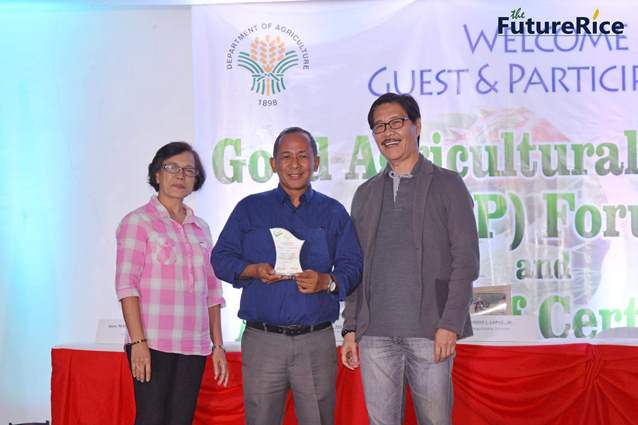
Roger Barroga (center), FutureRice Program Leader, is awarded the plaque of recognition by Dr. Irene M. Adion (left), OIC-Regional Technical Director for Research and Regulation, and Engr. Roy M. Abaya (right), Regional Executive Director of Department of Agriculture-Regional Field Office (DA-RFO) III.
PhilRice’s FutureRice Farm has been awarded with a good agricultural practices (GAP) certification by the Bureau of Agriculture and Fisheries Standards at the DA-RFO 3, November 3.
According to Engr. Angel S. Tulabut, Region III Gap Inspector, Central Luzon currently has the most number of GAP certified farms in the Philippines. It has 83 GAP-certified farms and 71 farms with pending GAP approval. Of the 83 certified farms, 61 are found in Nueva Ecija including the FutureRice farm.
FutureRice received the GAP certification for ensuring food safety and quality while keeping high regard for environmental protection and workers’ health, safety, and welfare; producing quality and safe agricultural crops for consumers; and facilitating access of Philippine agricultural crops to neighboring ASEAN markets and other foreign markets.
The said farm is also the first to receive a GAP Certification for rice and vegetables at PhilRice. The farm underwent on-site evaluations of its current farming practices, such as record keeping, maintenance of facilities, quality production, and management. Its farm produce also passed chemical tests performed by the Bureau of Plant Industry.
Aside from being a demo farm for rice farming innovations, the FutureRice Farm is being developed as an agritourism destination. One of its attractions is the famous rice paddy art, which recently featured celebrities Kathryn Bernardo and Daniel Padilla. Students, farmers, government officials, and tourists from neighboring provinces flock to PhilRice Central Experiment Station to view the unique art.
It also showcases clean energy facilities, drone technology, advanced farm machines, and an experimental field that demonstrates hybrid, inbred, and traditional rice varieties. It also has facilities for indoor and outdoor activities.
Led by Roger Barroga, PhilRice’s deputy executive director for administration, the FutureRice program was implemented in 2013 to attract people, integrate knowledge and practices on sustainable agriculture through high-end technology, and promote clean, green, practical, and smart farming practices to farmers. It is supported by DA-RFO III, AGFUND, and Project IPaD.




